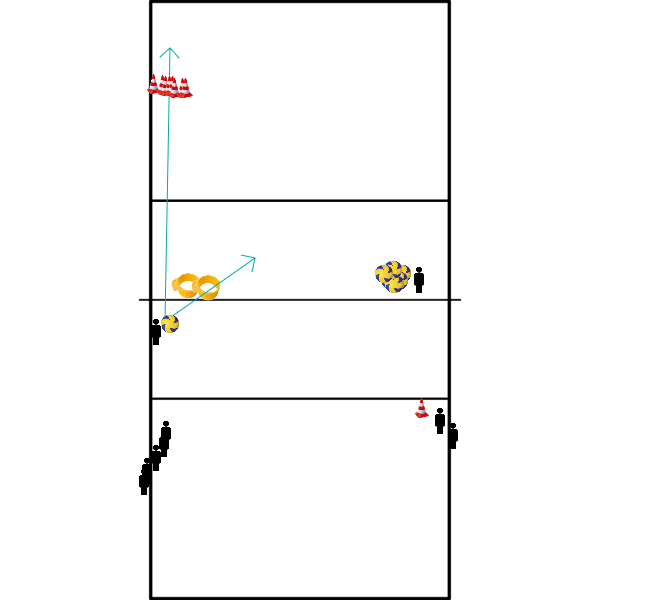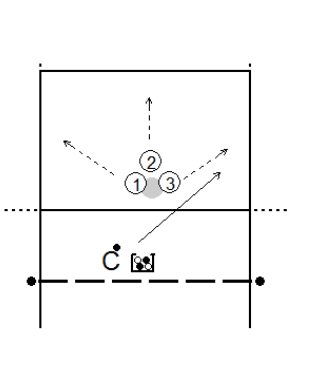Volleyball drills for technique attack / smash / spike / hitting
- three people in the field.
- Coach hits the ball into the field
- then sets it up in three
- over the net
- who plays the ball over the net retrieves it and puts it in the cart.
- 4 players are in the line-up. 1 of the players SV.
- 3 other players serve.
- Perfect pass to SV
- SV plays behind 3 meter line for attack.
- 10 balls change.
- team is in line.
- serve on team
- team builds attack, completes it.
- Coach plays next ball immediately,
- 4x in quick succession.
- Service
- Pass to mid-forward on 2 or 4,
- Attack quickly on 3 or long ball to 4 or 2, or......3 meter attack
- advantage of variation of the playmaker,
- and attack is shifted to other side,
- difficult to defend,
- and mid-forward opponent must defend in the block.
Goal of the exercise:
Fine tuning techniques
Explanation of the exercise:
- From the right front, balls are hit on the own half to position 4 / 5.
- The defender attacks his own ball again.
- Follow your own ball. N
- After your attack you start serving from position 5 straight ahead.
4 game forms for warming-up for youth teams.
Game form 1: ( Korfvolley )
- Theme of the training: Playing above the head
- Explanation:
- A game of Korfball, same rules, but it is only allowed to score with an overhand ball.
- More difficult:
- The ball must be pinned by a team mate.
- Easier:
- Draw a circle around the basket, where only the attacking team is allowed to go.
- Scoring:
- 1 point for every ball scored
- 2 points for a teammate who passes the ball to the attacker.
Game form 2: ( Basketball volleyball )
- Theme of the training: Playing with hands
- Clarification:
- Make 1 group per basket and throw the ball under a left or right angle from under the basket.
- The players have to play the ball underhand in the basket.
- Harder:
- Hit the ball in a controlled way instead of throwing it in.
- Catch the ball before it hits the floor via the basket.
- Easier:
- Throwing the ball straight instead of in an angle.
- Reduce the distance to the basket.
- Point count:
- 1 point for every scored ball
- 2 points for a passed ball
- 3 points if the ball is caught in follow-up.
Game form 3: ( Tennisvolley )
- Theme of the training: attack
- Explanation:
- Tension the net at tennis height and make teams of 3 or 4 players.
- The ball must be played back and forth and smashed into the ground on your own side.
- The receiving side may not let the ball bounce first.
- Turn over every time the ball is played to the other side.
- You will see that this is a very difficult exercise when the ball lane recognition is not in order.
- Harder:
- Jump on attack
- Easier:
- No spin
- Ball may not end within 3 meters
- Point count:
- 1 point for every scored ball
Game form 4: ( Trefvolley )
- Theme of the training: Defence
- Explanation:
- Game of dodgeball where all the defensive techniques of volleyball are allowed as defence.
- Player throws the ball to his opponent, who tries to defend the ball so his teammate can catch it.
- Harder:
- Field must be divided into front and backfield, catching teammate must be in the frontfield.
- Thrown ball must be a batted ball.
- Easier:
- Throw with 2 hands from the neck.
- Throw with 2 hands from the chest.
- Point count:
- 1 point for every ball defended
General:
- The warm-up for youth should be playful and always with the ball.
- Do not warm up too much, stretch, play volleyball immediately.
- On one side of the net there are 6 players. (If they are having trouble with the set up, the trainer can take over this spot).
- The remaining players stand on the other side of the net.
- They start the game, by serving.
- The 6 players build an attack. Pass/Set up/Smash.
- Just play the point.
- Full turn at the smash.
- Communication by calling LOS, good pass.
- The goal of this exercise is to tactically put away or hit the ball.
- This by means of a tap ball on midmid, or a ball deep on position 1.
- By using baskets you can create a 'constant' block, which eventually can be replaced by a real block.
- The pawns at position 1 can best be replaced by a cupboard, over which the ball must fall, over the 'defender'.
- The trainer hits a ball, or plays a ball in, which is first passed to the distributor,
- the playmaker gives a set-up to the outside.
- The attacker decides whether to try a short passed ball at midmid (where there is a hoop),
- or looks for position 1 with a hit or a fast overhand ball.

- All on the back line
- two walk to the net
- make a block jump
- and go backwards again
- the coach puts the ball in play
- and they set up an attack.
- 1, 2, and 3 start in the middle
- C bounces the ball and the players move to their defensive positions.
- C attacks one of the defenders.
- after the defence, set-up and 3 meter attack
- after 5 times a new 3

- A line-up of six players stand in the field.
- On the other side stands the trainer, included if necessary.
- Three players stand at the net with 1-2 balls and one server stands (this can also be the trainer).
- The first ball is served and handled by the 6 players.
- Where the attack is played, the person standing with the two balls at the net, throws the ball back over the net very quickly.
- In this way the attacking cover is trained.
- From this cover, all attackers must of course return as quickly as possible to give support.
- A short run is important.
- You will therefore be training a lot of blocking without actually blocking
- Keep on blocking until the net players have run out of balls, until it is not safe or until they simply cannot play anymore.
- Rotate through a position every so often so that side-out is trained on every position.
- After throwing the ball, the net players should look back to make sure that the previous ball doesn't secretly roll back under the net.
- Trainer gets the ball from player 1
- Trainer throws the ball to SV and calls on the position where the attack will take place. ( position 2 or 4).
- Attackers on position 2 or 4 finish the attack, go get the ball themselves.
- Player 1 goes to position 3 (SV).
- The attacker who finished the attack goes back to the starting position.








